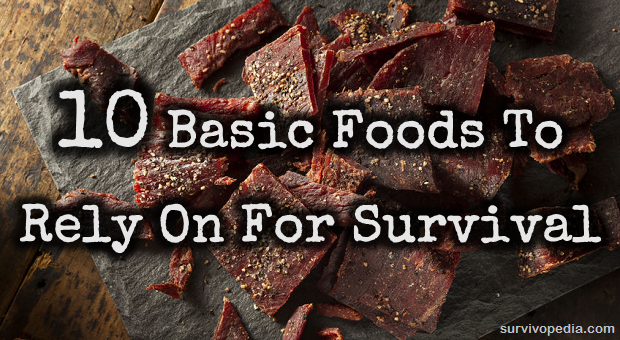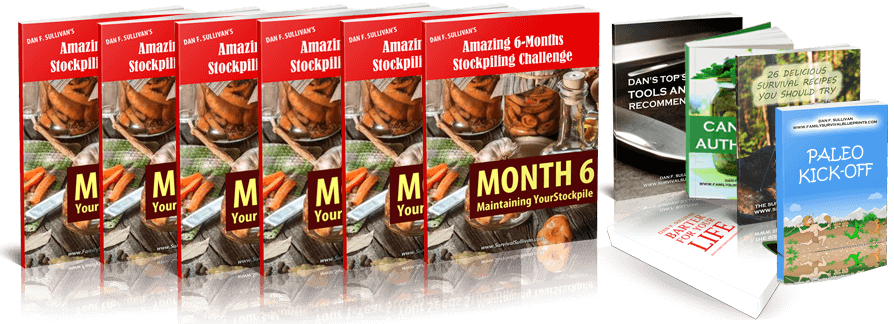If you’re only preparing foods to survive, it doesn’t have to be fancy but it does need to be safe and nutritious. Some foods aren’t nutrient-dense but they are packed with carbs that will give you energy to keep going. You need to learn how to prepare these foods BEFORE SHTF. Today we’re going to talk about some basic foods that you need to know how to prepare for survival.
Bread and Biscuits
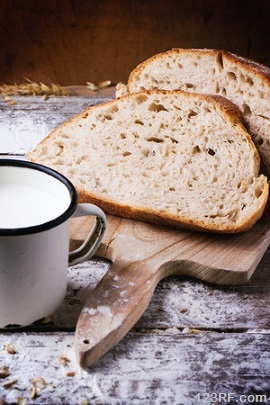 Though bread and biscuits aren’t necessarily nutrient-dense, they are light to carry and provide a quick source of carbs.
Though bread and biscuits aren’t necessarily nutrient-dense, they are light to carry and provide a quick source of carbs.
They also help other foods such as meats go a bit further toward filling your belly. You can stretch your valuable food supply by knowing how to combine flour, butter, milk and salt to make biscuits.
Plus, once you know how to make biscuits, you can get fancy by adding fruits, spices (cinnamon is awesome in a biscuit!), vegetables (my favorite is a bit of jalapeno pepper) or sugar to spice them up.
Add some yeast and sugar and you can make bread, too.
Gravy
Gravy is another one of those foods that will help you fill bellies and stretch your food supply. All you need is fat, flour, salt, pepper and water or milk. I personally like to start my gravy by adding water to the browned flour to get the base going, then add some milk to make it creamy but in a pinch it can be made with just water. Or, if you have a cow but a limited supply of water, you can always use just milk.
Butter
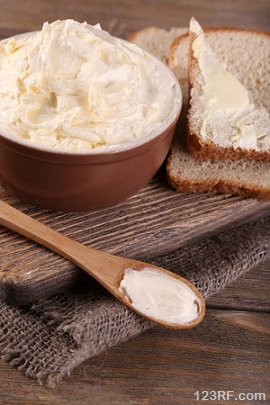 Butter is a good source of fat in a survival situation. Considering how easy it is to make and how easy it will be to barter, knowing how to make butter in a survival situation is a no-brainer. All you need to do is skim the cream from your milk and shake it in a jar. It helps if you let the cream sit out for a few hours. Then you just put it in a jar and shake it.
Butter is a good source of fat in a survival situation. Considering how easy it is to make and how easy it will be to barter, knowing how to make butter in a survival situation is a no-brainer. All you need to do is skim the cream from your milk and shake it in a jar. It helps if you let the cream sit out for a few hours. Then you just put it in a jar and shake it.
You’ll notice chunks forming, then you’ll see it forming a solid clump. Once you have the solid clump, stop shaking. Pour the contents of the jar through a cheesecloth or linen towel then rinse the butter under cool water. Put the butter in a bowl. Don’t throw away the juice – that’s buttermilk and it makes excellent biscuits and pancakes.
Using a wooden spoon or flat spatula, work the butter around in the bowl so that you press the rest of the liquid out of it. Once you have all of the liquid out of it, add salt to taste and you’re done. You can also use a butter churn if you have one to make larger batches.
Jerky
Jerky is light and is a great source of protein. It’s easy to carry and lasts for a week or two after you make it if you don’t preserve it as long as you prepare it properly.
Slice the meat as thin as you can get it, season it with your choice of seasonings or marinade and hang it to dry over a fire, assuming you don’t have power. You can even dry it in the sun if it’s hot and sunny enough but you need to start in the morning.
Flour
If SHTF, you may not have a source of flour. If you have access to wheat or nuts, you can make your own flour by using a hand mill or a mortar and pestle, though the latter isn’t a great choice because it takes so long. Remember that homemade flour will still have the oils from the nuts or seeds that it’s made from so it will go rancid fairly quickly.
Milk
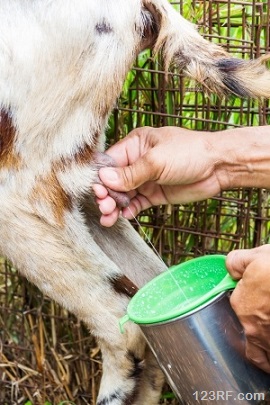 There are a couple of different kinds of milk that people consider palatable; cow milk and goat milk.
There are a couple of different kinds of milk that people consider palatable; cow milk and goat milk.
Regardless of which one you choose (or have access to), you need to follow proper sanitation procedures in order to keep bacteria from making you or your family sick.
Wash the udders well and use clean pails. Strain the milk before you drink it.
If you want to go a step further, you can pasteurize it by heating it to 161 degrees for 15 seconds.
Cheese
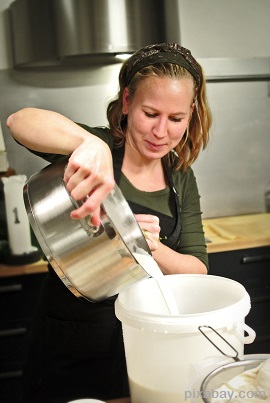 Cheese is a good source of protein even if you’re a lacto-vegetarian. You can make a simple cheese from milk by adding a bit of acid such as vinegar or lemon juice. The important part here is that you need to find the right ratio of milk to acid.
Cheese is a good source of protein even if you’re a lacto-vegetarian. You can make a simple cheese from milk by adding a bit of acid such as vinegar or lemon juice. The important part here is that you need to find the right ratio of milk to acid.
Too much milk and it won’t curdle. Too much acid and it will be tart. Just bring your high-fat milk (you can add cream if you’d like) to just below a simmer, using low heat, then add in the acid and some salt.
You’ll see it instantly separate into curds of cheese and whey, the liquid part. Strain these out by placing it in a cheesecloth or linen towel then squeeze the rest of the whey out. You have a smooth cheese similar to ricotta. If you want it firmer, squeeze it a bit more then chunk it up and add some cream and salt to it and you have cottage cheese.
If you want it a bit firmer, place it in a linen cloth and press it for a couple of hours between two plates with a weight on top. This results in cheese that has a feta consistency. Press it like this overnight and you’ll have cheese firm enough to cut into cubes. You can always spice it up any way that you’d like before pressing it.
For Vegetarians
Without a doubt, food on the fly will require some advance preparation if you’re a vegetarian. You can dehydrate fruits for carbohydrates and can vegetables for more nutrition. If you’re a lacto-vegetarian, biscuits are a good source of carbs, too. If you have access to nuts, you can make nut butters. Beans are going to be a staple for you too, so dry or buy plenty for your stockpile.
Rendered Fat
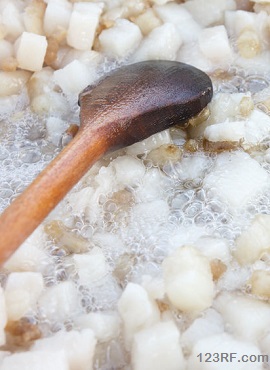 This process can be a bit stinky but the rendered fat will come in handy in a variety of ways. You can use it to cook with or to waterproof your clothing. It’s a bit of a process but will be worth it. The actual process is a topic of its own that I touched on in this article.
This process can be a bit stinky but the rendered fat will come in handy in a variety of ways. You can use it to cook with or to waterproof your clothing. It’s a bit of a process but will be worth it. The actual process is a topic of its own that I touched on in this article.
Pemmican
Pemmican was used by Native Americans for centuries as a near-perfect combination of protein, fat and carbohydrates. It’s energy-dense and it takes your body a while to digest it so it’s a good source of long-term energy. You make it simply by using equal parts (use weight, not volume) of dried meat, rendered fat and dried berries.
Related: DIY Pemmican: Bread of the Wilderness
Pulverize the dried meat and berries into minced portions, almost a powder. Add a handful of the fat and start working it in to the meat and berries. Continue mixing the fat in until you have everything mixed thoroughly and it’s sort of dough-like.
If you have chunks of fat left, continue kneading until it melts into the mixture. Separate out into balls about the size of ping-pong balls and store in an air-tight container. As long as the meat was dried completely and the fat was rendered properly, you don’t need to refrigerate pemmican. Eat is in small portions though because it IS energy-dense. You don’t need much of it to survive and even thrive.
There are many foods that will serve you well in a survival situation but it’s important that you learn how to make them before you NEED to know how. If you have any other food that you think should be included on the list, tell us about it in the comments section below.

